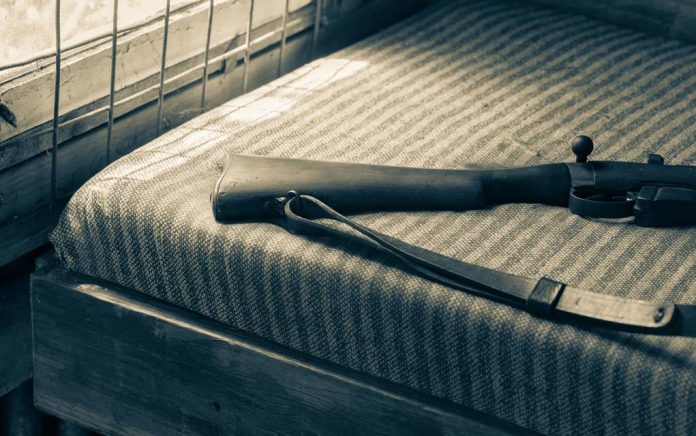(SurvivalDaily.com) – It’s the middle of the night, your children are asleep in the next room, and suddenly you wake to the sound of shattering glass. The sanctity of your home has been destroyed by an intruder with unknown intentions. Are you prepared to gather your family and protect them?
Code Words
Unfortunately, home invasion is a very real threat in our society. In this situation, it falls on us to protect our family, which is easier to do if they’re prepared ahead of time.
To train your family to wake up and move to a predesignated safe room, start by establishing a code word they can immediately recognize. Make sure you practice using it, both while the family is awake and by waking them up using it. Having the code word in place won’t help if no one will wake up when you yell it out.
Anatomy of a Safe Room
Before training to head to a safe room, do your best to make sure it really is safe. Once you have your family trained to wake up and move to it, test its actual safety with various scenarios and upgrade as needed. Let’s be honest, very few people can afford to create a panic room — you probably aren’t going to be installing bulletproof walls and high-tech gadgets here. That said, you can still set up your space to effectively slow down an intruder and give you a defensive advantage while you wait for law enforcement to arrive.
When choosing which room to turn into your safe zone, select one that’s easily accessible to the entire family. Also, try to make sure it doesn’t have windows. If it’s a good place to hide from a tornado, it’ll likely be a good choice for a safe room.
Basements are a viable option to consider, if your home has one — and it’s accessible without having to run past the intruder. The temperature remains fairly even here and it is below the frost line, so it should be easier to keep warm in a winter disaster scenario. Make sure it has good ventilation though, and that a bad guy can’t squeeze through it once you’re on lockdown.
Disguising the entrance to the room is another tactic you can employ. If the invader can’t find you, they can’t hurt you. This is especially useful if you have rooms that are already relatively hidden or a basement that can’t be detected from outside the home.
If you’re forced to use a room that has windows, (unfortunately, some homes don’t have rooms without them) you can install shatterproof glass, or security window film that’ll give you extra time to react, should an intruder attempt to enter that way. Cover these windows with heavy curtains to prevent anyone from being able to see in.
To create an effective safe room, you’re going to have to do a few simple renovations, starting with the door. Most doors on the inside of a home are cheap and hollow, designed for privacy more than security. Replace it with a solid (preferably steel) door that can withstand more than one kick.
Next, reinforce the door frame and the locks. Most new doors come with a door frame that can be installed with it; just make sure you put in plenty of 3” screws when putting it in. If you already have a solid internal door to the room, replace the screws in the strike plate with longer screws so that they anchor into the stud behind the door frame. That’ll help them hold should an intruder throw their body weight into the door.
If you’re still afraid that someone could get through your door, add a single face deadbolt. This will share the force with the standard door lock and give you added protection. Other options include a barricade bar that goes across the door to help prevent it from opening, or a floor door brace.
When arranging the room, make sure you have heavy furniture in a position to move against the door to further block it from opening. A heavy dresser can be pushed against the door, and will help to keep an intruder from getting through.
Also, keep furniture, like a bed, placed in areas that you can use as cover to fire from if the bad guy does manage to get through the door. Try to have this set up at a ninety-degree angle from the door, so that you’ll have more time to identify the target and react.
What to Stock?
Stock your safe room as you would for any type of disaster, not only a home intruder. Here’s a handy check-list of items you should keep in your safe room:
- Phone, HAM Radio, or some other means to contact the outside world.
- First aid kit
- Food & water
- Flashlights
- Extra batteries
- A hand-crank radio
- Defensive weapons – preferable a firearm if the law allows it in your area
- A portable toilet – just in case
- Any medication you or your family needs that wouldn’t be in your first aid kit.
- Fire extinguisher
Stay Safe
The ultimate goal of your safe room is to be a place to retreat and call for help. If you do face an intruder, and you’ve barricaded your family inside the room, you have a strong argument for shooting in self-defense should the prowler make it in somehow.
Train your family to go straight to the safe room, and make sure everyone knows what to do. Have one person phone 911, and another gather small children if you have them – leaving you free to defend the room with your firearm (if you can legally own one).
The goal is to survive until the police arrive. Losing a television is better than losing a life and you can’t assume a thief wouldn’t use physical harm to get what they want.
Do you have a plan in place should your home be invaded? Do you have a designated safe room? Reply to your email and let us know, we would love to hear from you!
Copyright 2021, SurvivalDaily.com

















